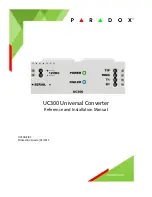UM10516
All information provided in this document is subject to legal disclaimers.
© NXP B.V. 2012. All rights reserved.
User manual
Rev. 1 — 27 March 2012
6 of 16
NXP Semiconductors
UM10516
230 V 7 W GU10 buck converter SSL2101 reference board
4. Functional
description
4.1 General
The 230 V, 7 W buck reference board uses the SSL2101 control IC to drive a load of up to
5-LEDs. The SSL2101 is a Switched Mode Power Supply (SMPS) controller with an
integrated MOSFET. Detailed information about the SSL2101 operation is contained in the
SSL2101 SMPS IC for dimmable LED lighting data sheet
.
The converter operates in Discontinuous Conduction Mode (DCM) or Boundary
Conduction Mode (BCM). In BCM, valley switching detection is used to minimize magnetic
component and switching losses while enhancing efficiency. A valley-fill circuit is added to
obtain high-power factor.
The reference board is triac dimmable and can be used in combination with most leading
and trailing edge dimmers. During dimming, the rectified mains voltage is averaged and
attenuated and supplied to both BRIGHTNESS and PWMLIMIT pins of the SSL2101. As a
consequence, the converter duty cycle or frequency is reduced and as a result the LED
output current.
Dimming compatibility is defined as smooth dimming without any flashing artifacts across
the complete dimming range. This reference board provides a dimming compatibility of
> 85 % when tested with a current selection of 30 trailing and leading-edge dimmers.
5. Reference board connections
The GU10 LED driver board takes a 230 V, 50 Hz mains supply and supports a 5-LED
load.
Remark:
Make all connections with the input power is switched off.
•
Connect the 5-LED load as output load together with power meter at both inputs and
outputs.
•
Connect V
IN
(230 V/50 Hz) using an isolating transformer to the input connection
points of the buck converter. Alternatively use an AC power supply with limited output
current capability (for example; 200 mA).
•
Increase V
IN
to 230 V and measure the different parameters as shown in
Table 2
.
•
When testing dimmer compatibility, connect a leading or trailing edge dimmer
between V
IN
and the buck converter input connection points.
Remark:
Use protective a shield over application and never touch the board when
measuring or testing.
Table 2.
Input and output parameters
V
IN
(V)
I
I
(mA)
PF
P (W)
V
O
I
O
P
O
(%)
230
41
0.9
8.5
15.6
415
6.5
0.76


















